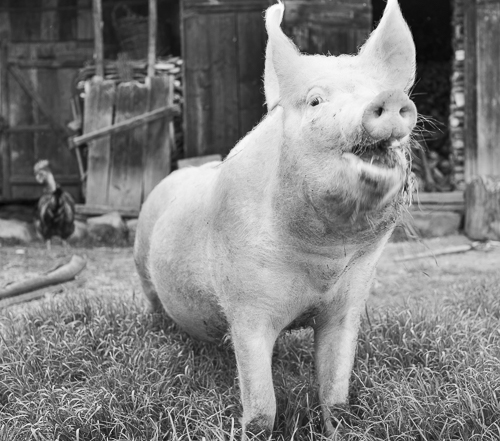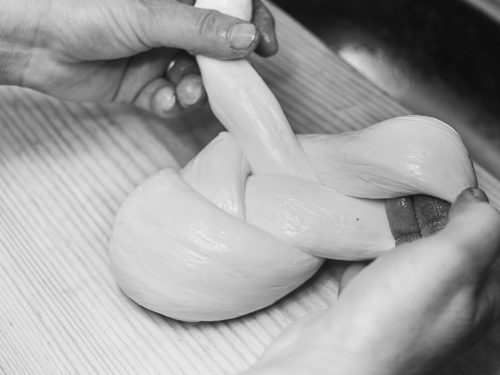Having visited Zita Tofalvi in the morning, later we went to visit Rózsika and Arpad Szász because they also live on the high level plain above the town of Corund. Both of them grew up in this area, but he worked for many years as an electrician in mines before getting a pension. Then, they lived in Corund before buying this farm.
The farm is located in a beautiful place, surrounded by wildflower meadows and deciduous forests, a neighbour was passing on a horse-drawn cart, songbirds were singing, a cuckoo was calling and no cars were passing. A rural idyll!
Since they were expecting us, we were served a wide selection of their home-made cheeses and bacon, while we got pancakes with urdă cheese with mulberry jam as dessert.
Having eaten, we were free to have a look at the farm where a group of hens, normal ones and Transylvanian ones with naked neck, together with a rooster went around pecking until they got fed cereals by Ms..Szász, who also had to tempt one hen and her chickens inside a coop with tidbits. One single guineafowl, which I was told, was used as an alarm in case birds of prey were approaching, was also roaming freely, but some poultry is taken by foxes or birds of prey anyway.
Three pigs were also being raised at the farm and they need to weigh about 220 kg when they are slaughtered. That is, they weigh much more than pigs, which are raised commercially, when they are slaughtered. While the pigsty was being cleaned, the pigs were let out one by one and they seemed very happy, eating grass and walking around the courtyard freely.
The Szász couple had 6 cows, all of which were grazing on a communal meadow, while a cowherd was looking after them, They were milked in the morning, then they were let out and they would walk with cows from nearby farms to a communal meadow and come back in the evening. During our visit, Mr Szász followed them home the last stretch, but when they reached the barn, each cow knew which cubicle to go to. Finally, both husband and wife milked them, while one male calf just had to suckle his mother’s teats. Having finished, he was hardly controllable and he was let out such that he could jump and run as much as he wanted, looking very happy.
Besides, the cows on this farm go outside twice daily to drink water from a spring in winter, making them in good shape and ready to go grazing in spring.
Having finished milking the cows, Mr. Szász brought the fresh milk inside the kitchen where it was poured into a container through a filter. Since they got milk twice daily, Ms. Szász had cheese mass in various stages on the way to become mature cheese. She grated cheese mass made the day before and put it in warm salt water, then she formed the grated mass into a clump, which she rolled into a sausage on a bench and tied it into a braid, She formed other parts of the grated mass into a flat piece which she extended, finally turning it a rose, showing us she is a real artist.
Regarding sharing of work, he does the repetitive task of churning butter, while she does the demanding task of making cheese with more or less complex shapes.
Some of the cheeses were mixed with oregano, cumin or walnuts and some cheeses were smoked in a small smokehouse next to the farm.
They also have a wood-fired bakery oven where they bake bread filled with mashed potatoes once a week.
They had three dogs and three cats, but unfortunately one dog had been taken by wolves the preceding winter.
Since winters are harsh and long in this area, they have to collect a lot of hay in order to feed their animals throughout winter. They only use cow dung to fertilise their fields because they can’t afford artificial fertilisers.
They grow potatoes and vegetables in a small garden near the farm, they have pear, apple, walnut and plum trees and they make rose hip and mulberry jam.
The pigs looked far from weighing 220 kg, but when they do, there will surely be a busy time after having slaughtered them. Then, the whole carcass will be turned into sausages, cold cuts, hams, etc.
All in all, it seemed like they took very good care of their animals and that that both man and animals were living in harmony.


